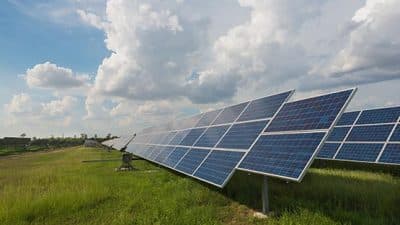
– David Noss, California, Md.
Sunspots are storms on the sun’s surface that are marked by intense magnetic activity and play host to solar flares and hot gassy ejections from the sun’s corona. Scientists believe that the number of spots on the sun cycles over time, reaching a peak—the so-called Solar Maximum—every 11 years or so. Some studies indicate that sunspot activity overall has doubled in the last century. The apparent result down here on Earth is that the sun glows brighter by about 0.1 percent now than it did 100 years ago.
Solar wind, according to NASA’s Marshall Space Flight Center, consists of magnetized plasma flares and in some cases is linked to sunspots. It emanates from the sun and influences galactic rays that may in turn affect atmospheric phenomena on Earth, such as cloud cover. But scientists are the first to admit that they have a lot to learn about phenomena like sunspots and solar wind, some of which is visible to humans on Earth in the form of Aurora Borealis and other far flung interplanetary light shows.
Some skeptics of human-induced climate change blame global warming on natural variations in the sun’s output due to sunspots and/or solar wind. They say it’s no coincidence that an increase in sunspot activity and a run-up of global temperatures on Earth are happening concurrently, and view regulation of carbon emissions as folly with negative ramifications for our economy and tried-and-true energy infrastructure.
“[V]ariations in solar energy output have far more effect on Earth’s climate than soccer moms driving SUVs,” Southwestern Law School professor Joerg Knipprath, writes in his ‘Token Conservative’ blog. “A rational thinker would understand that, especially if he or she has some understanding of the limits of human influence. But the global warming boosters have this unbounded hubris that it is humans who control nature, and that human activity can terminally despoil the planet as well as cause its salvation.”
Many climate scientists agree that sunspots and solar wind could be playing a role in climate change, but the vast majority view it as very minimal and attribute Earth’s warming primarily to emissions from industrial activity—and they have thousands of peer-reviewed studies available to back up that claim.
Peter Foukal of the Massachusetts-based firm Heliophysics, Inc., who has tracked sunspot intensities from different spots around the globe dating back four centuries, also concludes that such solar disturbances have little or no impact on global warming. Nevertheless, he adds, most up-to-date climate models—including those used by the United Nations’ prestigious Intergovernmental Panel on Climate Change (IPCC)—incorporate the effects of the sun’s variable degree of brightness in their overall calculations.
Ironically, the only way to really find out if phenomena like sunspots and solar wind are playing a larger role in climate change than most scientists now believe would be to significantly reduce our carbon emissions. Only in the absence of that potential driver will researchers be able to tell for sure how much impact natural influences have on the Earth’s climate.
CONTACTS: NASA’s Marshall Space Flight Center, www.solarscience.msfc.nasa.gov; Token Conservative Blog, www.tokenconservative.com; IPCC, www.ipcc.ch.
Dear EarthTalk: Are the United States’ vast oil shale resources a potential source of energy?
– Larry LeDoux, Honolulu, Hawaii
Oil shale is a fine-grained sedimentary rock that contains significant amounts of kerogen, a solid mixture of organic chemical compounds that can be converted into synthetic liquid fuel similar to oil, or into shale gas similar to petroleum-derived natural gas. Geologists believe there is more oil shale out there in the rocks of the world—three trillion barrels worth of fuel—than there is oil in existing reserves globally.
Oil shale has been mined extensively in Brazil, China, Estonia, Germany, Israel and Russia, but up to two-thirds of the world’s supply lies in the Green River basin of the western United States, including parts of Wyoming, Utah and Colorado. To date, these American oil shale resources remain virtually untapped, but an 11th hour executive order by the Bush administration in 2008 put two million acres of Bureau of Land Management (BLM) land across Wyoming, Utah and Colorado up for lease to oil shale extractors.
Other nations with oil shale reserves have been mining them for decades for power generation and other uses, but American enthusiasm has run hot and cold, depending on oil prices. The U.S. was bullish on oil shale during the 1970s oil shocks, but when gas prices fell again, so did the enthusiasm for oil shale.
American companies didn’t look into mining domestic oil shale again until 2003—again, thanks to spiking oil prices. George W. Bush’s Energy Policy Act of 2005 officially opened federal lands to oil shale extraction. But then once again lowered oil prices, along with environmental concerns and growing enthusiasm for renewable energy sources left oil shale’s future in the U.S. again uncertain.
For their part, environmental groups are unequivocally against oil shale extraction. For one, extracting operations destroy affected landscapes, forcing plants and animals out, with regeneration unlikely for decades. Another big issue with oil shale extraction is water usage. The process requires as much as five barrels of water—for dust control, cooling and other purposes—for every barrel of shale oil produced.
Oil shale extraction is also very energy-intensive, and as such is no solution to our global warming woes. Researchers have found that a gallon of shale oil can emit as much as 50 percent more carbon dioxide than a gallon of conventional oil would over its given lifecycle from extraction to tailpipe.
Due to these concerns and others, 13 environmental groups, including the Wilderness Society, Sierra Club and Natural Resources Defense Council, teamed up in January 2009 to file suit against the federal government for opening up all that western U.S. land to oil shale development. The suit contends that the BLM failed to properly consider air quality and endangered species impacts in the region. The groups also contend that the development would require the construction of 10 new coal-fired power plants in order to get at and process the oil shale, significantly upping the carbon footprint of the entire region.
Green groups hope that the Obama administration will overturn Bush’s decision to lease development rights on the land, which is near three national parks in one of the least developed parts of the U.S.
CONTACTS: Bureau of Land Management, www.blm.gov; Wilderness Society, www.wilderness.org; Sierra Club, www.sierraclub.org; Natural Resources Defense Council, www.nrdc.org.
GOT AN ENVIRONMENTAL QUESTION? Send it to: EarthTalk, c/o E/The Environmental Magazine, P.O. Box 5098, Westport, CT 06881; submit it at: www.emagazine.com/earthtalk/thisweek/, or e-mail: [email protected]. Read past columns at: www.emagazine.com/earthtalk/archives.php.










